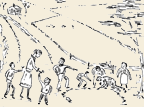
Fall 2002

 |
|
 |
| Home | Index | Museums | Blog | Authors | Site Map | About |
|
A Picture of CanandaiguaAs It Once Wascontributed byRichard F. PalmerThe Ontario Repository, Tues., Sept. 8, 1818The Village of CanandaiguaA few days since, three gentlemen, from a laudable curiosity, volunteered their services to take a census of the inhabitants residing within that part of the town of Canandaigua, which is incorporated as a village, and to ascertain the number of buildings it contains. It will doubtless be interesting to our citizens, and gratifying to the public, to know the result. From the statement it appears that the village contains 1,788 souls, of whom 929 are males and 859 females, and including 136 blacks, of whom 30 are slaves. Of the whole number, 471 are under the age of 10 years, 484 between 10 and 21, and 833 over 21. Of buildings: Their are 217 dwelling-houses, 39 stores, 76 shops, 30 offices, and 153 stables. The above are exclusive of the Public Buildings, viz. One Congregational Meeting-House, one Episcopal Church, one Methodist Chapel; a Court-House, a Jail, and a County Clerk's Office, an Academy and five School-Houses. Of the buildings, we believe not one is vacant, except half a dozen stores. It ought to be added, that besides the Academy, which is undergoing a thorough renovation, and the common and Sunday schools, there are two respectable private Female Seminaries, in which the higher branches of education are successfully taught. The style of building may be said to be not inferior to any, since travellers, who make public their remarks, call our village not only well, but extravagantly built. The above surely presents a flattering account of the prosperity of the pleasant village in which it is our happiness to dwell. While other places round about us, boast how early they have become great — old Canandaigua has been growing apace, displaying the sturdy vigor and healthful aspect of natural increase. But flattering as this account may appear, some danger is to be apprehended from the number of taverns and groceries embraced in the limits of the village. Who, that has not counted them, would suspect that there are no less than fourteen taverns? Of groceries, there are also too many. The public convenience does not require such a number of inns — and their toleration cannot but be detrimental to the morality of the town. Public officers, whose duty it is to regulate these things, should recollect, that it is much easier to prevent, than to root out the evils which grow from such causes. © 2002, Richard F. PalmerIndex to articles by Richard F. PalmerCLR Blog | Site Map | Contact CLR |